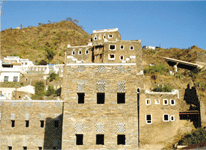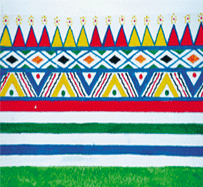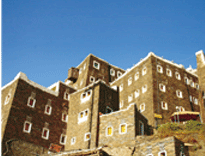

Asir:
A Harmonious Blend of Tradition and Modernity
Saudi Arabia is known for its great diversity whether in terms of demography, architecture, or other features at the national level. This diversity is mainly due to its huge geographical spread. Asir in the south is an obvious example of this diversity. A distinctive aspect of Asir is its architecture renowned for outstanding beauty. What follows is an attempt to capture some of the scintillating beauty of Asir, the province with a picture postcard- look.
Saudi Arabia is known for its great diversity whether in terms of demography, architecture, or other features at the national level. This diversity is mainly due to its huge geographical spread. Asir in the south is an obvious example of this diversity. A distinctive aspect of Asir is its architecture renowned for outstanding beauty. What follows is an attempt to capture some of the scintillating beauty of Asir, the province with a picture postcard- loo
Asir embodies a harmonious mix of tradition and modernity. It bears an eloquent testimony to its creative genius and uniqueness
Clay, stone, and wood are the basic building material of these houses.
“A thousand welcomes...Ten thousand welcomes” is a familiar greeting in Asir when you arrive in its picturesque capital, the pride of
Houses here are different from anywhere else in
But with development programs sweeping across
However, whereas other regions embraced the innovations wholesale, Abha gave them a guarded welcome by accepting modernity within the framework of its traditions and moral values. It embraced the new, but only to the extent de=sirable. The result was a beautiful blend of the new and the old.
The basic materials used in a typical Abha house are clay, stone, and wood. However, as a good quality clay that can withstand its frequent rain is rare, thin layers of rock called “Ragf” are packed horizontally on those clay bricks. They form irregular but attractive protrusions through the facade of a building all around, helping not only to dispel the water but also to give it an added attraction. This wall of clay and rock gets thinner as we reach the top. The end result is a beautiful tower-shaped house tilting inwards, the very hallmark of southern houses, Asir particularly.
 In the more mountainous areas of Abha, houses are built on the mountain itself facing the farms, with added towers for protection called “Qasabah”. In these houses, clay and layers of rock are very much still dominant. Not less prominent though is the small windows that are dispersed around the house at regular intervals. This alternation between window and rock is what makes these houses so recognizable wherever you find them. Added to that are special carvings that any traditional house would not be complete without them. And, of course, to top all that, there are those striking colors we mentioned before. These colors enhance the beauty of the carvings to a great extent, boosting the horizontal and vertical flow of the house.
In the more mountainous areas of Abha, houses are built on the mountain itself facing the farms, with added towers for protection called “Qasabah”. In these houses, clay and layers of rock are very much still dominant. Not less prominent though is the small windows that are dispersed around the house at regular intervals. This alternation between window and rock is what makes these houses so recognizable wherever you find them. Added to that are special carvings that any traditional house would not be complete without them. And, of course, to top all that, there are those striking colors we mentioned before. These colors enhance the beauty of the carvings to a great extent, boosting the horizontal and vertical flow of the house.
A little bit about how modernity has tried to project itself, especially during the current developmental boom. New types of buildings that are modern but at the same time reflect the class and excellence of the original local architecture are springing up in Abha. The materials used are very modern and technologically superior, but they still retain features of the old architecture. There are those who swallow the bait of modernity hook, line and sinker. But, in many cases, they have also contributed something to the ambience through the uniqueness of their choice (of color and design).
Al-Muftaha village is a model for the blending of the original with the contemporary, in every sense of the term. The old Al-Muftaha was an ancient neighborhood with a handful of people. Then it was rebuilt using modern methodology but retaining the features of an old village, which typically consisted of groups of houses clustered together along the stretches of those undulating inner and outer alleys. The houses were typical of Asir: thick walls and small ventilations showing through them; also ever-present are the rocks that protect those clay walls from the rain and lend a beautiful finishing touch.
The new
 Abha, and Asir in general, has become a tourist destination of some distinction, whether for those in the Kingdom or all over the Gulf. This is why the region has worked feverishly to develop its resources. Besides Al-Muftaha, there is also the Sauda village in Abha itself, a village consisting of 22 units and a three-story hotel-- all featuring recreational attractions. There are also administrative offices alongside a shopping complex. The village, with its exuberant atmosphere and idyllic surroundings carpeted with greenery and inviting open spaces, is a haven for any tourist yearning for peace and tranquility amid a very traditional backdrop. All the architecture here is very original, though modern, and in sync with the greater Abha area.
Abha, and Asir in general, has become a tourist destination of some distinction, whether for those in the Kingdom or all over the Gulf. This is why the region has worked feverishly to develop its resources. Besides Al-Muftaha, there is also the Sauda village in Abha itself, a village consisting of 22 units and a three-story hotel-- all featuring recreational attractions. There are also administrative offices alongside a shopping complex. The village, with its exuberant atmosphere and idyllic surroundings carpeted with greenery and inviting open spaces, is a haven for any tourist yearning for peace and tranquility amid a very traditional backdrop. All the architecture here is very original, though modern, and in sync with the greater Abha area. In keeping with the drive to develop the City of
The project is an expression of Asir’s culture, religion and commerce, and represents a highly successful attempt to emphasize the traditional architecture of Abha in an extremely central and outstanding location. Undoubtedly, it is an imposing work of art, and a fount of inspiration for lovers of architecture.